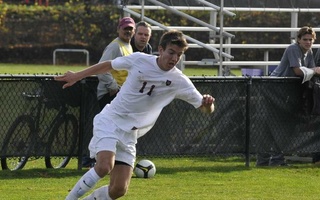“Since I have been around for so long, [I] was trying to figure out in another construct if it [were] worth all the time and money to be dedicating to ultimate, but this professional activity was something that was new and exciting,” he said. “And it fit into my lifestyle, so I’m excited to be a part of it.”
The MLU front offices provide all the logistical work that Graham and other players once had to do themselves when they played at the club level. Players on the Whitecaps practice a few nights a week and receive a small stipend for their games.
“We’re not kidding ourselves, we aren’t the NFL,” he adds. “Some of the players on the team put in 40, 50, maybe 60 hours a week [to their careers], and then play professional Ultimate on the side.”
Despite now being a professional sport, the teams and players know that there is not a large preexisting fan base. Reaching down to youth Ultimate will be a major focus of the new Boston Franchise.
“There is a lot of action within the sport, and the people who started it were just looking for the best way to capture it,” he said. “How to make it marketable, make it thrill and get it out to more people. We are reaching out in sort of a grassroots effort to a lot to local high school teams, and local leagues that have been around here to make sure we make our team known to the ultimate community which is strong in not just the Boston area, but MA and New England as well.”
One high school that doesn’t need much outreach about ultimate is Amherst Regional High School, in Amherst, MA.
In 1989, English teacher Tiina Booth, gathered a couple students who lingered after class and she simply asked them if they wanted to play Frisbee. The rest is history.
Booth’s group of students soon evolved one of the best teams in the nation. Her creation of the Amherst Invitational Tournament in 1992, the oldest and largest high school ultimate tournament to date, brought the sport to a national level for high school students.
Booth was Herscu’s coach at ARHS, and she also has a former player on the Whitecaps.
“In the past six months, I’ve see more growth and more interesting operations taking hold than I’ve ever seen before,” Booth said. “There are new companies making gear, professional leagues forming, and two new online ultimate magazines just last year. It seems like it is just getting some kind of critical mass that I have not felt ever before."
Much of this growth is due to her efforts in raising youth participation in the sport. With a partner, she transformed her daily Ultimate camps in Amherst into the first national over-night camp for Ultimate, which now is serving students who come from overseas
“I think about ultimate a lot and how we can make it bigger and better,” she added. “And by bigger I don’t mean having all these bells and whistles, but bigger in having Frisbee in every kid’s hand who wants it.
Other efforts have come from a Harvard Alum, Nathan Salwen, who created ultimate day camps for elementary students in Amherst, which indirectly is how Herscu learned about the sport, in the second grade.
Ultimate has been receiving more visibility in the younger age groups thanks to the Internet. For example, Booth has had some of her high school players appear on ESPN’s daily Top-Ten Countdown.
This spread is also greatly due to Booth’s work as an author. In 2008 she wrote a book titled, Essential Ultimate: Teaching, Coaching, Playing.
Read more in Sports
Harvard Track and Field Teams with Yale to Defeat Oxford-CambridgeRecommended Articles
-
 Around the Water Cooler: Wherein the Ivy League Never Stops Ballin'
Around the Water Cooler: Wherein the Ivy League Never Stops Ballin' -
Men's Squash Bounces Back On The RoadFollowing their first loss of the season, the No. 3 Harvard men’s squash team was able to rebound at the Pioneer Round Robin Tournament in Amherst and take down the No. 13 University of Western Ontario and No. 23 Amherst College on Saturday.
-
 Brian Rogers Selected in MLS Supplemental Draft
Brian Rogers Selected in MLS Supplemental Draft -
After Error is Revealed, Professor Pair Defends Core ConclusionsAfter coming under fire last week for a Microsoft Excel error and what have been called unconventional research methods in a prominent 2010 macroeconomics paper, Harvard Kennedy School professor Carmen M. Reinhart and economics and public policy professor Kenneth S. Rogoff are continuing to defend their research, saying that despite one mistake, their core conclusions remain unchanged.
-
Rejecting edX, Amherst Doubts Benefits of MOOC RevolutionFor the more than 60 percent of Amherst College professors who voted against partnering with edX, reaching hundreds of thousands of students around the world does not align with the college’s mission to be “a purposefully small residential community.”
-
Launch of Digital Dickinson Archive Clouded by ControversyWednesday’s launch of the Emily Dickinson Archive, a Harvard-led open-access website compiling hundreds of images of the poet’s surviving manuscripts, was supposed to be a celebration of successful scholarly collaboration. But a public dispute with Amherst College over control of and credit for the project has clouded the once-heralded launch.













